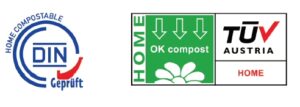Developments in biodegradable food packaging
Two issues are being hotly debated at present, the amount of fresh food being wasted, and the pollution caused by oil-based plastic films. A large part of the solution to both is the development of biodegradable packaging.
The use of plastic film (bags) compared to paper packaging (bags) plays an important role in minimising moisture loss from, bread, baking, crisps, raspberries, grapes, etc. This keeps food fresh and minimises waste. However, plastic film is not worth recycling into new plastic as it contains polymers that are often incompatible, has strong colours, and is uneconomic to separate and clean (Pringle and Barker, 2004, Bibliography). When discarded it does not break down, leading to unsightly road verges and in the worst cases, to drains and rivers choked with garbage.
While plastics manufacturers will defend the use of oil-based plastic films with often questionable claims, I believe the demise of oil-based film manufacturers is inevitable unless they change to producing biodegradables. All organic materials on earth are biodegradable; oil-based plastics are not. Society must move to using materials that are either worth recycling or biodegradable.
There is a race being played out by chemists and companies developing biodegradable plastics that have the moisture retaining properties of conventional plastic films. These are made from maize starch, potatoes, sugar cane, and a host of other natural products. These can be digested by fungi, bacteria, and soil-based animals, to create organic nutrient in the form of fertiliser for plants to take up to grow food.
Biodegradable film and tray manufacturers produce packaging to two different standards, one for composting in industrial-type in-vessel containers, at a temperature of 70°C. The other type decomposes in garden compost heaps, at 0-25°C. Since a proportion of biodegradable plastic film will be discarded as litter, the low temperature rotting that will occur in waste on road-verges means that only the home compost standard is acceptable if litter made of this material is to decompose.
Vegware, an Edinburgh based supplier of biodegradable cups, trays, bags and cutlery, say their products are mostly suitable for industrial composting or anaerobic digestion. This requires cafes, restaurants and take-aways to have contracts with industrial waste treatment companies to take used cups, trays and packaging for composting or anaerobic digestion. Some of their products are however suitable for home composting. Obviously, their paper products compost well, so long as they are shredded first to help the digestion process.

While not food packaging, increasingly publishers are sending out their magazines in compostable plastic sleeves or paper envelopes. I put these in my New Zealand style compost bins, and after some early failures to decompose, the latest versions all seem to degrade in three months. These included the RSPB magazine Nature’s Home, Potato Review, and the Rohan catalogue. The Co-op’s new biodegradable carrier bag decomposed well, although it took Ian Ferguson, the Co-op’s packaging manager, nine years to change his mind about compostable plastics! For best results, chop up the packaging, so it becomes well mixed with the food waste and so gives the micro-organisms a balanced diet.
A last benefit from compostable packaging is that it can be used as a feedstock to create either compost or biogas. Like any organic feedstock in a sealed chamber, it will produce methane, which can be used to drive a generator, fuel vehicles, or be piped to homes to heat buildings. Biogas does not contribute to global warming, unlike natural gas, (can you explain why), so is a useful form of heating or vehicle fuel.
An issue to be resolved is how to identify biodegradable from oil-based plastic film. This is important if a waste processor is trying to recycle plastic film, as any biodegradable material will introduce weakness into the plastic. The compost label will help here. As more compostable packaging comes onto the market, composting or AD will become the normal disposal route for food packaging, so identification will become less of an issue.
